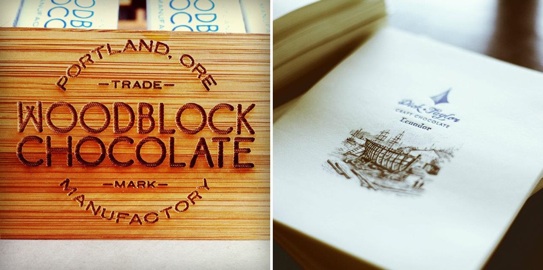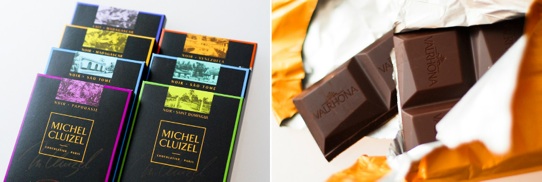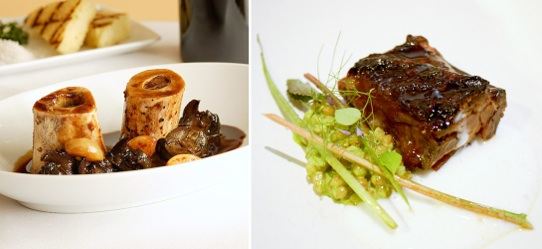The Meadow, Mark Bitterman, Portland, Oregon, OR, West Village, New York, NY, Manhattan, Salt, Flowers, Chocolate, Cocktail Bitters, Wine, Liquor, Pineau des Charentes, Flake Salt, Sea Salt, Sel Gris, Coarse Grey Salt, Hot Chocolate, Bitters, Adam Elmegirab, Hella, Miracle Mile, Brooklyn Bitters, Pineau Francois 1er, Rogue Chocolatier, Dick Taylor Craft Chocolate, Woodblock Chocolate, Valrhona, Michel Cluizel, Seattle, Chefs, Recommendations, Where to eat in Portland, Where to drink, Where to shop




Q. In your two stores in Portland and New York, you sell a range of products from salt to flowers to chocolate to cocktail bitters to wine. How did you end up with that eclectic combination under one roof?
A. It absolutely just built itself around us. Flowers are something that my wife and I have always been really passionate about. Wherever you live that’s civilized, flowers are an integral part of your daily life. They are what beautify and connect you to nature. We’ve always loved flowers, so we knew we needed to have a flower shop.
Salt was the inevitable -- over the last twenty years, I had collected a lot of salt. It was very personal and we found that we had stories and ideas through the salt that we were able to share with people and it just took off.
Similarly, the chocolate and the wine were life long interests. We couldn’t turn down the opportunity to share our eclectic tastes.
Who
Mark Bitterman and Jennifer Turner Bitterman are the owners of The Meadow stores in Portland, OR and New York, NY.
Why
Purveyors of flowers, artisanal salts, chocolate and cocktail bitters. Let their expertise guide your selections.
North Portland - Portland, Or | West Village - New York, NY
The Meadow | Mark Bitterman & Jennifer Turner Bitterman
November 8, 2011

The Meadow
Multiple Locations
Salt / Chocolate / Bitters / Flowers
North Portland
3731 N. Mississippi Avenue
Portland, OR 97227
T: 503.288.4633 / 1.888.388.4633
West Village
523 Hudson Street
New York, NY 10014
T: 212.645.4633 / 1.888.388.4633
Website:
Blogs:








Photographs courtesy of The Meadow
Book
- Salted: A Manifesto on the World's Most Essential Mineral, with Recipes [buy it]
Recommended By
Recommendations
Mark Bitterman’s recommendations for salt, bitters, cocktails and chocolate, plus where to eat, drink and shop in Portland, Seattle and New York.



“Always look for sea salt. Such things as table salt have that twang of the chemical industry about them.... It’s amazing how appropriate a particular salt can be to a certain dish.”

A. I was about 20 years old and I was eating something and I was tripping out over this crazy beautiful ingredient that I had never seen before... it was salt. To discover that salt was actually a beautiful, complex ingredient with character, soul and flavor and a heritage of its own -- that was quite a discovery.
When you consider that it is a food you eat every single day and it’s probably the single most important ingredient that exists in any culinary tradition’s die, that captured my imagination. Beyond that, I immediately fell in love with the people that make salt, their stories and passion for what they’re doing was very captivating.
Q. Do you ever use table salt or kosher salt?
A. Fuck no! No way! I hate table salt and I despise kosher salt. I think they are far more evil than strip malls and Velveeta cheese. They should definitely never be included in any thinking, conscious persons diet. In a nutshell, the reason I don’t like either table or kosher salt is that I don’t like refined chemicals -- I don’t eat them. I certainly don’t go out and buy them and put them into my food. I eat junk food like anybody in the world, but I do it as a part of my obsession with kitschy, yummy, gross junk food. I would never go out and intentionally source chemically refined anything and put it into my food at home -- especially when there are polar opposites available in beautiful, natural, unrefined, artisan salt.
Types Of Salt

A Variety of Salts
Photograph courtesy of The Meadow
Fleur De Sel
A delicate finishing salt that can also double as a cooking salt.
Sel Gris
A very coarse, granular, minerally salt. It’s great for finishing hearty foods, but is also a good cooking salt. Generally, it’s an inexpensive way to get into using natural salts for your cooking.
Flake Salts
Like Maldon Salt and there are many, many others -- there is a lot of variety. I don’t often recommend Maldon Salt, because it is not very original of me to do so, but it is damn good salt. A more original recommendation would be Bali Rama (Bali Taksu), a beautiful arrow head-shaped salt that just crunches and pops. I also love to recommend Halen Môn, from Wales. We have some niche ones, like an Alaskan flake salt that is absolutely spectacular. Our house flake salt which is massive pyramidal crystals is a really good example of the style.
Traditional Sea Salt
They are as diverse as a rainbow and an often overlooked type of salt that is also the most common type of salt, like Red Hawaiian salt or Trapani sea salts. They aren’t labeled or aren’t an obvious type of salt. They are the type of salt that is just harvested once a year and ground up mechanically to the coarseness that is desired.
Salt For Everyday Use
Fleur De Sel
An inexpensive type of Fleur De Sel, The Meadow Fleur De Sel -- it’s what we sell in our store and also sell to restaurants. It’s become hugely successful. It’s beautiful and it’s a great all-purpose cooking salt. You can use it in your pasta water, your sauces, seasoning food in general, but also doubles as a great finishing salt. It’s your killer app salt.
Coarse Grey Sea Salt / Sel Gris
For most people, who don’t live near us or don’t want to buy salt over the internet, we usually recommend a coarse grey sea salt (sel gris). It’s not as easy to use, because it is coarser, chunkier and clunkier, but it’s a damn good salt and it dissolves beautifully.
The Price Of Salt
Honestly, it is just absurd. But the flip side is that we have really screwed ourselves up with the notion that salt is cheap. I think we are genetically wired for salt to be a scarcity. It was one of the rarest things on earth and one of the most necessary. It’s only in the last 150 years that it became this huge industrial commodity that is cheap.
This notion of cheap salt is counter to our nature and is extremely destructive in our food ways. Getting back to the notion that salt is expensive -- you prize it, you value it, you cherish it and are extremely mindful whenever you use it. Your food tastes better as a result and your nutrition is better.
Tips For Using Salt
This is more stylistic, not right or wrong... well, I think it is right and wrong, but not day and night. The general idea of finishing with salt is a very valuable technique. It doesn’t mean cooking with no salt, but skewing your use of salt towards then end of your cooking.
I think way too much has been made of salting early and often and I think it’s actually a technical mistake that chefs and cooks make alike. You should salt later and sparingly. I don’t think there is any truth to the idea of building up flavor with salt. Once salt has entered the food, it just never goes away. In fact, it concentrates because you lose moisture while you are cooking.
Finish, when possible, with a finishing salt that catches your fancy and you will get good results.
Unique Ways To Use Salt

Ways To Use Salt
Photographs courtesy of The Meadow
Finishing
The first, which is not so obvious to some people, is the idea of finishing salt. There is so much impact that salt gives when you are using it on top of food, as opposed to cooked through food. It’s one of the areas which we’ve had such an impact on people’s lives and cooking styles by really pushing on the idea of finishing salt.
Smoked Salts | Cocktails
Smoked salts not only give you some saltiness, but aroma too. Smoked salt on the rim of a cocktail glass gives you a really unexpected, beautiful smokey nose to your cocktail. For example, try mezcal and a dash of chocolate bitters with a smoked salt rim -- it’s so simple and so beautiful. It turns the mezcal into a Single Malt Scotch type of experience because it has all this great smokiness.
Soups | Hot Chocolate

Buying Salt
A general rule, as with any good ingredient, don’t look for the cheapest thing. It’s a really good rule of economics to put things into context here, no matter what salt you buy, it is always going to be the most powerful ingredient of flavor. So, why would you want to save money with the cheapest ingredient if it’s the most powerful?
Salt Recommendations
Takesumi Bamboo
Icarus-like, Takesumi is hatched from bamboo segments that were packed with Japanese deep sea salt and incinerated. The result, not so much a salt, as a carbonated topping. Takesumi Bamboo is the most exciting salt around for lean meats like venison or lean seafoods like halibut.
Takesumi Bisai
A new version of Takesumi Bamboo salt, it’s finer in grind, reminiscent of something settled to earth after the unlikely stratospheric collision between a comet and a water buffalo. Dust it over aioli for dipping with French fries. Take any food you like and roll it around in Takesumi Bisai to lend an umami-silvered sensation to the dining experience.
Hana Flake
Taut and menacing as an origami time bomb. Flavors that rasterize on the palate with digital speed. If you were off-planet somewhere, throwing down grilled eel donburi between fusillades with Kevlared warriors in a video game, this would be the salt. But if anything, its charms here on Earth are even greater. There is no salt in the world that expresses such vitality with such elegant restraint. Use with salad and other fresh vegetables, seaweed salad, any mollusk or fish sashimi, very dark chocolate ganaches, tart berry or stone fruit compotes.
[See details.]

Importance Of Cocoa Percentage
The darkness percentage of the bar is really unimportant. You can get very dark bars that are not even strong and you can get lighter bars that are incredibly complex. A lot of chocolate makers actually recognize that sugar provides a fantastic foundation and canvas for the flavors of the chocolate. Many of the most sophisticated chocolate makers are going more and more to high 60s and, at most, low 70s percentages. The other thing about it is each bean variety, strain, location, grower, roasting technique has a huge impact on the intensity and boldness of each bar.
How To Choose A Chocolate Bar
Here’s a funny one and it’s going to sound like I am being cute, but trust your instinct on packaging. Shop based on packaging -- the package is a good reflection of the values and the scale of the chocolate company. If the packaging turns you off, if it looks too slick, too corporate, too down home and funky, don’t buy it. I have eaten every single bar in the store at least once and I still suggest that consumers look around and see what catches their eye.
One other tip -- it is true that most refined and exquisite chocolates will come from smaller producers, because the best chocolate is often times not available on a very large scale.
Chocolate Recommendations | Small Production

Woodblock Chocolate | Dick Taylor Craft Chocolates
Photographs courtesy of Woodblock Chocolate & Dick Taylor Craft Chocolate
The best chocolates are being made by extremely inspired people in random places like Missouri, Montana and Utah.
Woodblock Chocolate
It's Portland's very first bean-to-bar chocolate! Venezuelan beans roasted, conched, tempered, molded, and wrapped in Southeast Portland. Every bar is a triumph of craftsmanship and deliciousness--so show them (and yourself) some love and try one.
Dick Taylor Craft Chocolate
It’s a new favorite and it’s just unbelievable. They have a Dominican Republic that is just wild, intense acidity and brightness and the most complex Ecuadorian chocolate I have ever tasted in my life. He’s from California and five years ago, you couldn’t find an artisan chocolate maker in California.
It’s really neat stuff and beautiful -- it’s sweetened with brown sugar. They are not quite as deadly serious as some of the others because of the brown sugar note, but as the same time, they are every bit as skilled. It’s a very beautiful chocolate.
Rogue Chocolatier
From Minneapolis and a fantastic chocolate bar.
AMMA Chocolate
A really beautiful one from Brazil from a fifth generation cacao farmer. It’s very, very exquisitely crafted and, in terms of craftsmanship, is probably the best crafted bar in South America right now.
[See details.]
Chocolate Recommendations | Larger Production

Michael Cluizel & Valrhona Chocolates
Photo Credit: EverJean [flickr]
Valrhona
I will always love and defend Valrhona. Not that they are ‘large,’ they are quite small as compared to the big guys. In the realm of high-end chocolate, they are larger.
Michel Cluizel
I also love Michel Cluizel, who are another popular French brand. In New York you see a lot of Cluizel around. It’s a quality product. It’s not a very original purchase, but you sure can’t say it’s not a very good purchase.
Guittard
Made in America. It’s very respectable company that I like a lot and tends to be overlooked by people. It’s cheaper, but nevertheless, they are good and very high quality. The company has extraordinary values with relationship to the industry and to growers.
[See details.]




FIND | Resources - Books

Salt | Salted
The only book on culinary salt that looks at it seriously is, unfortunately, my book [Salted: A Manifesto on the World's Most Essential Mineral, with Recipes]. I say unfortunately, because I wish there were three or four. Which is weird as hell. It’s kind of what I said when I got the James Beard Award. I do deserve the award, but only because I wrote the only fucking book on salt. I got to be the guy to write a book on the most universal, powerful, ancient ingredient in the world that no one had ever written a book about.
Chocolate | The New Taste Of Chocolate by Maricel E. Presilla
It’s my current favorite book on chocolate and we are selling in the store. She actually is one of the authors that deflated my interest in writing about chocolate, because she is so brilliant. It has a very organic or synthetic relationship to chocolate. She grew up with cacao and she knows it, not as a confection, but as an agricultural product and as an integral ingredient in cuisine. Her book is packed with the most beautiful written descriptions of chocolate from the ground up, along with brilliant and inventive recipes.
[See details.]


Bitters | A Gin & Tonic
Photograph courtesy of Brooklyn Hemispherical Bitters | Photo Credit: Global Jet [flickr]
We have 111 different bitters -- the biggest selection of bitters in the world is in our store.
Cocktails | Using Some Unique Bitters
It’s getting to be that time of year again and I definitely love a Manhattan cocktail. My style of cocktails are very austere, classic cocktails. With a Manhattan, set your bourbon or rye aside, it comes down to the quality of your vermouth and the quality of your bitters. My favorite Manhattan recipe is Rye, Dolin Sweet Vermouth and I would pick from either Bob’s Abbotts Bitters or Adam Elmegirab’s Dandelion & Burdock bitters. Bob and Adam are incredible masters.
I also do a white Manhattan and I use Dolin Blanc, a floral, more delicate version of sweet vermouth. But I would only do that if I had an extremely special type of bourbon, like Basil Hayden, which is light and floral.
Recommendations
I just published an article on a round-up of ten different Orange Bitters [found here]. We sell 111 different bitters and just three or four years ago, there was just Regan’s, Angostura, and Peychaud’s. So, it goes to show you what’s going on right now.
Some of these new bitters makers, like Hella out of Brooklyn or Miracle Mile out of L.A. are really quite special.
Miracle Mile Bitters
It’s a small batch bitters line from LA, from a former Hollywood executive. Girded with a firm bitterness, these bottles come in novel flavors like gingerbread, yuzu, sour cherry, and one of the best takes on chocolate-chili we've tasted.
The yuzu bitters, I’ve been drinking straight-up in club soda. I go a little heavy and use four to five drops.
Brooklyn Hemispherical Bitters
He does really good fruit bitters. They are the only artisan rhubarb bitters producers -- a rhubarb gin and tonic is the best thing ever.
Hella Bitters
Hella’s citrus bitters in a Negroni -- yum!
Aphrodite Bitters
Dr. Adam Elmegirab has concocted this blend of cocoa, coffee and spices that will turn your drink into a veritable love potion. Add a few dashes to a Spring Cocktail (gin, Bonal, and Benedictine) and let Cupid fly it down the bar to the cute thing with whom you've been trading glances. Adam is amazing.
[See details.]
Drink | Wine & Aperitifs
Americans have this idea about wine and beverages that it is just about taste and about consuming something. The Europeans don’t think about it that way at all. They think about it as a demarcation of a time in your day. It’s a rhythm and a moment you take with yourself, your family and your friends. Aperitifs aren’t something to suck down before a meal. Aperitifs are an hour to decompress and drink and communicate and share.
Pineau Des Charentes | Pineau Francois 1er
The idea of Pineau des Charentes -- which we’ve sold more Pineau des Charentes than the whole state of Oregon for the first couple of years of our business, because we were telling people how they can enjoy their day with a glass of Pineau -- one of our favorites is Pineau Francois 1er.
[See details.]
Find. | Seattle
Exotic Herbs | Tenzing Momo in Seattles Pike Place Market
It’s an urban place apothecary shop and it’s just really old school. They sell things that can kill you. I love the fact they have these really beautiful, crazy exotic herbs. That’s so cool, when they have that kind of seriousness in what they are doing.
[See details.]
Recommendations

Details of Mark Bitterman’s recommendations for salt, bitters, cocktails and chocolate, plus where to eat, drink and shop in Portland, Seattle and New York.
Food Recipes

- Buttermilk Leg Of Lamb With The Meadow Sel Gris
Cocktail Recipes

Eat | Chef Recommendations
New York & California | Thomas Keller
The most advanced salt user in the country, at an easily identifiable level. He’s doing an amazing job now, but he’s been doing it for ten years. He’s treated salt like it’s something that is important and distinctive and worth educating customers about for longer than anybody else I know. It’s not very original, but he deserves that place in American food culture.
Portland | Vitaly Paley of Paley’s Place
Here in Portland is this incredibly ingredient-driven, locavore-type restaurant with very well crafted food Paley’s Place. The day he found that there was such as thing as only cooking with high quality, hand-harvested, natural salt, he threw all of his kosher salt away. The food is better than before, which is hard to do.
Find. Eat. Drink. | Portland

Escargot à la Bordelaise with Roast Marrow Bones from Paley’s Place | Lamb Collar from Castagna
Photograph courtesy of Paley’s Place | Photo Credit: scaredy_kay [flickr]
Find | Andy & Bax
Lots of used rain gear, cheap.
[See details.]
Eat | Beaker & Flask
Great bartenders and chef, and one of the best places in town to find out just how geeky bartenders can be in pursuit of their own personal interest in the craft.
Eat | Castagna
For dinner. Portland-style molecular craziness, but good, grounded and unpretentious. New chef, but it’s said he is cut from the same cloth as the previous one and they came into the job together before the last one left for NYC. This is Portland’s only bastion of higher end, more technically challenging, refined cooking.
Eat | Ned Ludd
For brunch, not dinner. Chef Jason French has one of the most incredible treatments of veggies anywhere. Plus, great wood-fired dishes. Funky, small, typically Portland setting.
Eat | Paley’s Place
Chef Vitaly Paley: ingredient-driven, fine dining in intimate setting. Great, constantly changing, yet classic menu. Brilliant, visionary chef who is integral to the NW food movement and community. Uses only natural fleur de sel and other artisan salts in their kitchen!
[See details.]
Drink | Driftwood
Bartender Mike Roberson, a leader in the mixing community here, comfortable, dark loungy relic of the old Portland I knew when I first moved to town, back in my college days.
[See details.]
Find. Eat. Drink. | New York & Brooklyn

Pork Buns at Momofuku | Cocktails at Employees Only
Photo Credit: andersc77 [flickr] | Photograph courtesy of Employees Only
I am more of a forager in NYC.
Find | Cheese
I’m definitely a whore for cheese shops. I think that cheese shops are the type of business in America that is closest to what we do -- meaning they have a tremendous amount of expertise and passion in sourcing their ingredients and sharing that with customers one-on-one. It doesn’t happen in very many businesses in America. The merchant has become irrelevant, but they should be the connection between the product and the customer.
Find | Murray’s Cheese
They are great.
[See details.]
Find | Stinky Bklyn
A cute little shop. I love their store so much, I think of them as a competitor.
[See details.]
Eat | Fat Radish
Jamie Oliver-style great food. What is it with Fat in the name of restaurants that makes them good? Try the celery root pot pie with black garlic. Once in a while it actually seems feasible to become vegetarian.
Eat | Momofuku
I arrive 20 minutes before they stop their full menu. No line. The best and cheapest fun food in the city.
Eat | Socarrat
I love the paella at Socarrat and I’ll unconditionally order anything they do with squid ink, no questions asked.
[See details.]
Drink | Employees Only
Right next to our shop -- after teaching a salt class and winding down with a drink or two.
Drink | Corner Bistro
I’ve actually got Bistro fatigue, as the place is really a touch douchy now, and except for Harold and one fellow among the original help staff, not so friendly. My mother and father met there and I have been going there since I was a lad. My apartment is now across the street, so I still go. But I don’t linger. The fries are pretty weak, but the burger still eats like sushi for me, so I drop in, wolf one down and move on. Burger as health food.
Drink | Jane Street Hotel
Just go there, you’ll know what I’m talking about.
Drink | Angel’s Share
A speakeasy and no singles allowed, which makes it imperative to meet or bring someone ahead of time.
[See details.]
Drink | Hotel Delmano
Best Manhattan in… wait… well, that’s just how things are. The best Manhattans have officially forded the East River.
[See details.]
Jump To:
Topics: Aperitifs | Bitters | Chocolate | Resources & Books | Salt
Places: New York & Brooklyn | Portland | Seattle

Q & A






























